A Multi-Faceted Approach to Air Quality: Visibility Prediction and Public Health Risk Assessment Using Machine Learning and Dust Monitoring Data
Abstract
1. Introduction
2. Materials and Methods
2.1. Sampling Collection
2.2. Heavy Metal Analysis
2.3. PAH Analysis
2.4. Health Risk Assessment for Heavy Metals
2.5. PAH Health Risk Assessment
2.6. AI-Based Models for Visibility Prediction
2.7. Statistical Analysis
3. Results and Discussion
3.1. Particulate Matter (PM) and Heavy Metal Concentrations
3.2. Health Risk Assessment
3.3. PAH Health Risk Assessment
3.4. AI-Based Regression Models for Visibility Prediction
Linear Regression Model
3.5. MLP Regressor Model
SVM-RBF Model
4. Conclusions
Supplementary Materials
Author Contributions
Funding
Institutional Review Board Statement
Informed Consent Statement
Data Availability Statement
Acknowledgments
Conflicts of Interest
References
- Harrison, R.M.; Yin, J. Particulate matter in the atmosphere: Which particle properties are important for its effects on health? Sci. Total Environ. 2000, 249, 85–101. [Google Scholar] [CrossRef]
- Larssen, T.; Hagen, L. 6.4. Suspended particulates (TSP/SPM). In Air Quality in Europe, 1993: A Pilot Report; European Environment Agency: Copenhagen, Denmark, 1996. [Google Scholar]
- Russell, A.G.; Brunekreef, B. A focus on particulate matter and health. Environ. Sci. Technol. 2009, 43, 4620–4625. [Google Scholar] [CrossRef] [PubMed]
- Mukherjee, A.; Agrawal, M. World air particulate matter: Sources, distribution and health effects. Environ. Chem. Lett. 2017, 15, 283–309. [Google Scholar] [CrossRef]
- Zhang, X.; Zhang, X.; Chen, X. Valuing air quality using happiness data: The case of China. Ecol. Econ. 2017, 137, 29–36. [Google Scholar] [CrossRef]
- Manisalidis, I.; Stavropoulou, E.; Stavropoulos, A.; Bezirtzoglou, E. Environmental and health impacts of air pollution: A review. Front. Public Health 2020, 8, 14. [Google Scholar] [CrossRef]
- Williams, C.G.; Samara, F. Changing particle content of the modern desert dust storm: A climate × health problem. Environ. Monit. Assess. 2023, 195, 706. [Google Scholar] [CrossRef]
- Al-Dousari, A.M.; Ibrahim, M.I.; Al-Dousari, N.; Ahmed, M.; Al-Awadhi, S. Pollen in aeolian dust with relation to allergy and asthma in Kuwait. Aerobiologia 2018, 34, 325–336. [Google Scholar] [CrossRef]
- Tsiouri, V.; Kakosimos, K.E.; Kumar, P. Concentrations, sources and exposure risks associated with particulate matter in the Middle East Area—A review. Air Qual. Atmos. Health 2015, 8, 67–80. [Google Scholar] [CrossRef]
- Schweitzer, M.D.; Calzadilla, A.S.; Salamo, O.; Sharifi, A.; Kumar, N.; Holt, G.; Campos, M.; Mirsaeidi, M. Lung health in the era of climate change and dust storms. Environ. Res. 2018, 163, 36–42. [Google Scholar] [CrossRef]
- Hamdan, N.M.; Alawadhi, H.; Jisrawi, N. Elemental and chemical analysis of PM10 and PM2.5 indoor and outdoor pollutants in the UAE. Int. J. Environ. Sci. Dev. 2015, 6, 566–570. [Google Scholar] [CrossRef]
- Basha, G.; Ratnam, M.V.; Kumar, K.N.; Ouarda, T.B.M.J.; Kishore, P.; Velicogna, I. Long-term variation of dust episodes over the United Arab Emirates. J. Atmos. Sol.-Terr. Phys. 2019, 187, 33–39. [Google Scholar] [CrossRef]
- Nazzal, Y.; Barbulescu, A.; Howari, F.; Yousef, A.; Al-Taani, A.A.; Al Aydaroos, F.; Naseem, M. New insights on sand dust storm from historical records, UAE. Arab. J. Geosci. 2019, 12, 396. [Google Scholar] [CrossRef]
- Al-Taani, A.A.; Nazzal, Y.; Howari, F.M.; Yousef, A. Long-term trends in ambient fine particulate matter from 1980 to 2016 in United Arab Emirates. Environ. Monit. Assess. 2019, 191, 143. [Google Scholar] [CrossRef] [PubMed]
- Elsayed, Y.; Kanan, S.; Farhat, A. Meteorological patterns, technical validation, and chemical comparison of atmospheric dust depositions and bulk sand in the Arabian Gulf region. Environ. Pollut. 2021, 269, 116190. [Google Scholar] [CrossRef]
- International Agency for Research on Cancer (IARC). Arsenic, metals, fibres and dusts. In IARC Monographs on the Evaluation of Carcinogenic Risks to Humans; World Health Organization: Geneva, Switzerland, 2012; Volume 100C. [Google Scholar]
- Mahurpawar, M. Effects of heavy metals on human health. Int. J. Res. Granthaalayah 2015, 530, 1–7. [Google Scholar] [CrossRef]
- Wu, D.; Chen, L.; Ma, Z.; Zhou, D.; Fu, L.; Liu, M.; Zhang, T.; Yang, J.; Zhen, Q. Source analysis and health risk assessment of polycyclic aromatic hydrocarbon (PAHs) in total suspended particulate matter (TSP) from Bengbu, China. Sci. Rep. 2024, 14, 5080. [Google Scholar] [CrossRef]
- Singh, G. Multiple linear regression based analysis of weather data for precipitation and visibility prediction. In International Conference on Advances in Computing and Data Sciences; Springer Nature: Cham, Switzerland, 2023; pp. 60–71. [Google Scholar]
- Kim, B.Y.; Belorid, M.; Cha, J.W. Short-term visibility prediction using tree-based machine learning algorithms and numerical weather prediction data. Weather. Forecast. 2022, 37, 2263–2274. [Google Scholar] [CrossRef]
- Kim, B.Y.; Cha, J.W.; Chang, K.H.; Lee, C. Visibility prediction over South Korea based on random forest. Atmosphere 2021, 12, 552. [Google Scholar] [CrossRef]
- Castillo-Botón, C.; Casillas-Pérez, D.; Casanova-Mateo, C.; Ghimire, S.; Cerro-Prada, E.; Gutierrez, P.A.; Deo, R.; Salcedo-Sanz, S. Machine learning regression and classification methods for fog events prediction. Atmos. Res. 2022, 272, 106157. [Google Scholar] [CrossRef]
- Palvanov, A.; Cho, Y.I. Visnet: Deep convolutional neural networks for forecasting atmospheric visibility. Sensors 2019, 19, 1343. [Google Scholar] [CrossRef]
- Peláez-Rodríguez, C.; Pérez-Aracil, J.; Casanova-Mateo, C.; Salcedo-Sanz, S. Efficient prediction of fog-related low-visibility events with Machine Learning and evolutionary algorithms. Atmos. Res. 2023, 295, 106991. [Google Scholar] [CrossRef]
- Wang, L.; Lu, H.; Qu, G.; Ren, L.; Xu, Z.; Liu, G.; Yan, M.; Liu, Z. Cross-physical field prediction method for smoke field distribution in commercial building fire based on distributed optical fiber sensor. J. Build. Eng. 2024, 87, 109027. [Google Scholar] [CrossRef]
- Available online: https://dubaiairports.ae (accessed on 24 June 2025).
- Available online: https://www.aaco.org (accessed on 24 June 2025).
- Jiang, N.; Yin, S.; Guo, Y.; Li, J.; Kang, P.; Zhang, R.; Tang, X. Characteristics of mass concentration, chemical composition, source apportionment of PM2.5 and PM10 and health risk assessment in the emerging megacity in China. Atmos. Pollut. Res. 2018, 9, 309–321. [Google Scholar] [CrossRef]
- Du, Y.; Gao, B.; Zhou, H.; Ju, X.; Hao, H.; Yin, S. Health risk assessment of heavy metals in road dusts in urban parks of Beijing, China. Procedia Environ. Sci. 2013, 18, 299–309. [Google Scholar] [CrossRef]
- Nazzal, Y.; Orm, N.B.; Barbulescu, A.; Howari, F.; Sharma, M.; Badawi, A.E.; Al-Taani, A.A.; Iqbal, J.; Ktaibi, F.E.; Xavier, C.M.; et al. Study of atmospheric pollution and health risk assessment: A case study for the Sharjah and Ajman Emirates (UAE). Atmosphere 2021, 12, 1442. [Google Scholar] [CrossRef]
- Agency for Toxic Substances and Disease Registry (ATSDR). Guidance for Calculating Benzo(a)pyrene Equivalents for Cancer Evaluations of Polycyclic Aromatic Hydrocarbons; Agency for Toxic Substances and Disease Registry (ATSDR): Atlanta, GA, USA, 2022. [Google Scholar]
- Shen, H.; Tao, S.; Liu, J.; Huang, Y.; Chen, H.; Li, W.; Zhang, Y.; Chen, Y.; Su, S.; Lin, N.; et al. Global lung cancer risk from PAH exposure highly depends on emission sources and individual susceptibility. Sci. Rep. 2014, 4, 6561. [Google Scholar] [CrossRef]
- Alghamdi, M.A.; Hassan, S.K.; Alzahrani, N.A.; Al Sharif, M.Y.; Khoder, M.I. Classroom dust-bound polycyclic aromatic hydrocarbons in Jeddah primary schools, Saudi Arabia: Level, characteristics and health risk assessment. Int. J. Environ. Res. Public Health 2020, 17, 2779. [Google Scholar] [CrossRef]
- Jiang, R.; Xie, C.; Man, Z.; Afshari, A.; Che, S. LCZ method is more effective than traditional LUCC method in interpreting the relationship between urban landscape and atmospheric particles. Sci. Total Environ. 2023, 869, 161677. [Google Scholar] [CrossRef]
- World Health Organization. WHO Global Air Quality Guidelines: Particulate Matter (PM2.5 and PM10), Ozone, Nitrogen Dioxide, Sulfur Dioxide and Carbon Monoxide; World Health Organization: Geneva, Switzerland, 2021. [Google Scholar]
- MOCCE. UAE National Air Emissions Inventory Project Final Results; MOCCE: Lima, Peru, 2019. [Google Scholar]
- European Parliament and Council of the European Union. Directive 2008/50/EC of the European Parliament and of the Council of 21 May 2008 on ambient air quality and cleaner air for Europe. Off. J. Eur. Union 2008, L152, 1–44. [Google Scholar]
- Song, B.; Park, K.; Kim, T.; Seo, G. Analysis of spatiotemporal PM2.5 concentration patterns in Changwon, Korea, using low-cost PM2.5 sensors. Urban Clim. 2022, 46, 101292. [Google Scholar] [CrossRef]
- Dai, T.; Dai, Q.; Yin, J.; Chen, J.; Liu, B.; Bi, X.; Wu, J.; Zhang, Y.; Feng, Y. Spatial source apportionment of airborne coarse particulate matter using PMF-Bayesian receptor model. Sci. Total Environ. 2024, 917, 170235. [Google Scholar] [CrossRef] [PubMed]
- Pültz, J.; Banzhaf, S.; Thürkow, M.; Kranenburg, R.; Schaap, M. Source attribution of particulate matter in Berlin. Atmos. Environ. 2023, 292, 119416. [Google Scholar] [CrossRef]
- Alsanad, A.; Alolayan, M. Heavy metals in road-deposited sediments and pollution indices for different land activities. Environ. Nanotechnol. Monit. Manag. 2020, 14, 100374. [Google Scholar] [CrossRef]
- Ma, J.; Singhirunnusorn, W. Distribution and health risk assessment of heavy metals in surface dusts of Maha Sarakham municipality. Procedia-Soc. Behav. Sci. 2012, 50, 280–293. [Google Scholar] [CrossRef]
- Kamani, H.; Ashrafi, S.D.; Isazadeh, S.; Jaafari, J.; Hoseini, M.; Mostafapour, F.K.; Bazrafshan, E.; Nazmara, S.; Mahvi, A.H. Heavy metal contamination in street dusts with various land uses in Zahedan, Iran. Bull. Environ. Contam. Toxicol. 2015, 94, 382–386. [Google Scholar] [CrossRef]
- Trujillo-González, J.M.; Torres-Mora, M.A.; Keesstra, S.; Brevik, E.C.; Jiménez-Ballesta, R. Heavy metal accumulation related to population density in road dust samples taken from urban sites under different land uses. Sci. Total Environ. 2016, 553, 636–642. [Google Scholar] [CrossRef]
- Martínez, L.; Poleto, C. Assessment of diffuse pollution associated with metals in urban sediments using the geoaccumulation index (I). J. Soils Sediments Prot. Risk Assess. Remediat. 2014, 14, 1251–1257. [Google Scholar] [CrossRef]
- Chen, H.; Wu, D.; Wang, Q.; Fang, L.; Wang, Y.; Zhan, C.; Zhang, J.; Zhang, S.; Cao, J.; Qi, S.; et al. The predominant sources of heavy metals in different types of fugitive dust determined by PCA and PMF modeling in Southeast Hubei. Int. J. Environ. Res. Public Health 2022, 19, 13227. [Google Scholar] [CrossRef]
- Saeedi, M.; Li, L.Y.; Salmanzadeh, M. Heavy metals and polycyclic aromatic hydrocarbons: Pollution and ecological risk assessment in street dust of Tehran. J. Hazard. Mater. 2012, 227–228, 9–17. [Google Scholar] [CrossRef]
- Soltani, N.; Keshavarzi, B.; Moore, F.; Tavakol, T.; Lahijanzadeh, A.R.; Jaafarzadeh, N.; Kermani, M. Ecological and human health hazards of heavy metals and PAHs in road dust of Isfahan metropolis, Iran. Sci. Total Environ. 2015, 505, 712–723. [Google Scholar] [CrossRef]
- Al-Hemoud, A.; Al-Dousari, A.; Al-Dashti, H.; Petrov, P.; Al-Saleh, A.; Al-Khafaji, S.; Behbehani, W.; Li, J.; Koutrakis, P. Sand and dust storm trajectories from Iraq Mesopotamian flood plain to Kuwait. Sci. Total Environ. 2020, 710, 136291. [Google Scholar] [CrossRef] [PubMed]
- Abdulaziz, M.; Alshehri, A.; Yadav, I.C. Pollution level and health risk assessment of heavy metals in ambient air and surface dust from Saudi Arabia: A systematic review and meta-analysis. Air Qual. Atmos. Health 2022, 15, 799–810. [Google Scholar] [CrossRef]
- Sah, D.; Verma, P.K.; Kandikonda, M.K.; Lakhani, A. Pollution characteristics, human health risk through multiple exposure pathways, and source apportionment of heavy metals in PM10 at Indo-Gangetic site. Urban Clim. 2019, 27, 149–162. [Google Scholar] [CrossRef]
- Wei, X.; Ding, C.; Chen, C.; Zhu, L.; Zhang, G.; Sun, Y. Environmental impact and probabilistic health risks of PAHs in dusts surrounding an iron and steel enterprise. Sci. Rep. 2021, 11, 6749. [Google Scholar]
- Wang, W.V.; Lung, S.C.; Liu, C.H. Application of machine learning for the in-field correction of a PM2.5 low-cost sensor network. Sensors 2020, 20, 5002. [Google Scholar] [CrossRef]
- Zhang, H.; Zhang, S.; Pan, W.; Long, Z. Low-cost sensor system for monitoring the oil mist concentration in a workshop. Environ. Sci. Pollut. Res. Int. 2021, 28, 14943–14956. [Google Scholar] [CrossRef]
- Marzban, C.; Leyton, S.; Colman, B. Ceiling and visibility forecasts via neural networks. Weather. Forecast. 2007, 22, 466–479. [Google Scholar] [CrossRef]
- Ortega, L.C.; Otero, L.D.; Solomon, M.; Otero, C.E.; Fabregas, A. Deep learning models for visibility forecasting using climatological data. Int. J. Forecast. 2023, 39, 992–1004. [Google Scholar] [CrossRef]
- AlKheder, S.; AlKandari, A. The impact of dust on Kuwait International Airport operations: A case study. Int. J. Environ. Sci. Technol. 2020, 17, 3467–3474. [Google Scholar] [CrossRef]
- Gohel, H. Conscious study of impact of dust storm on aviation and airport management. J. Manag. Res. Anal. 2016, 4. [Google Scholar]
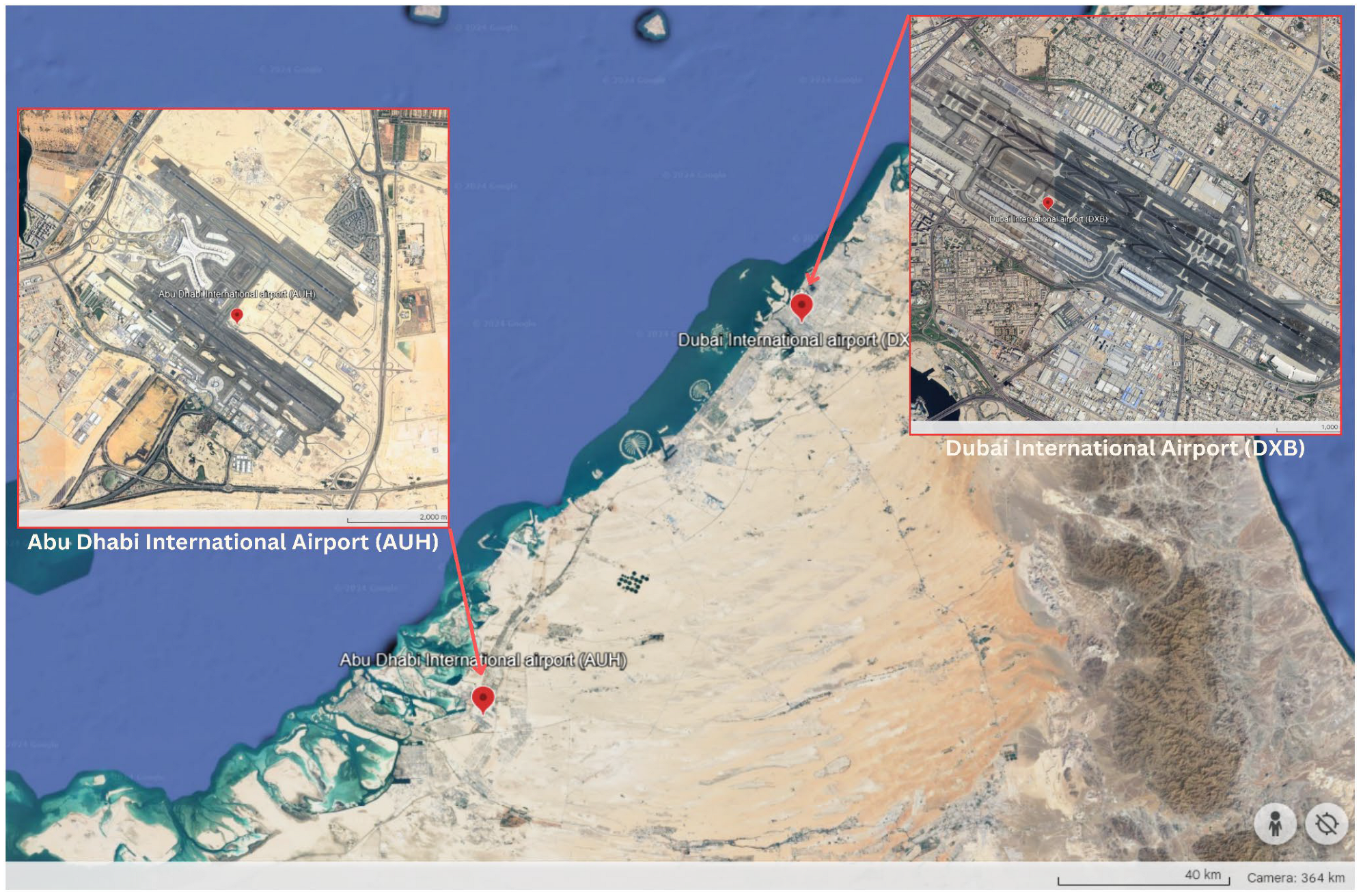

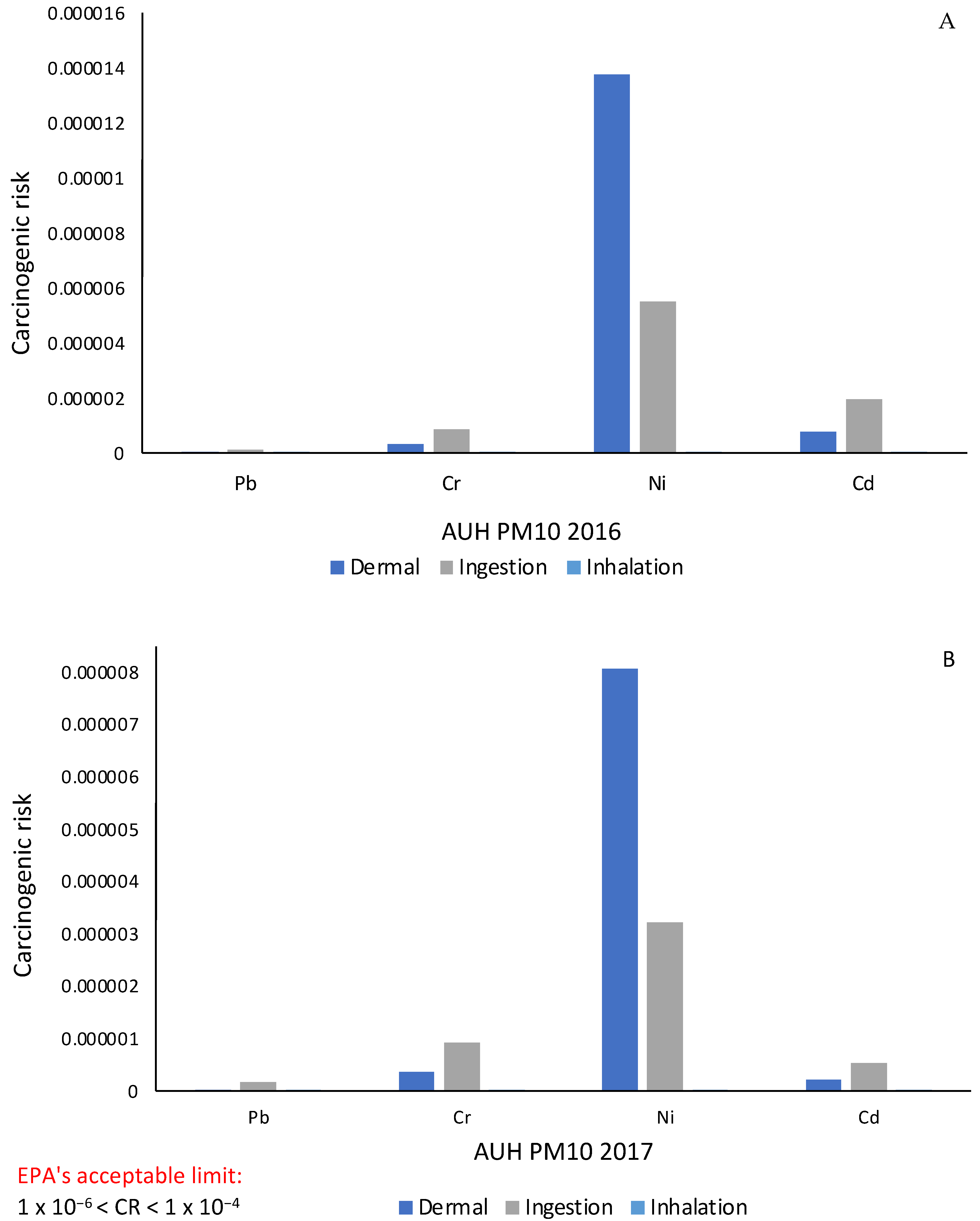
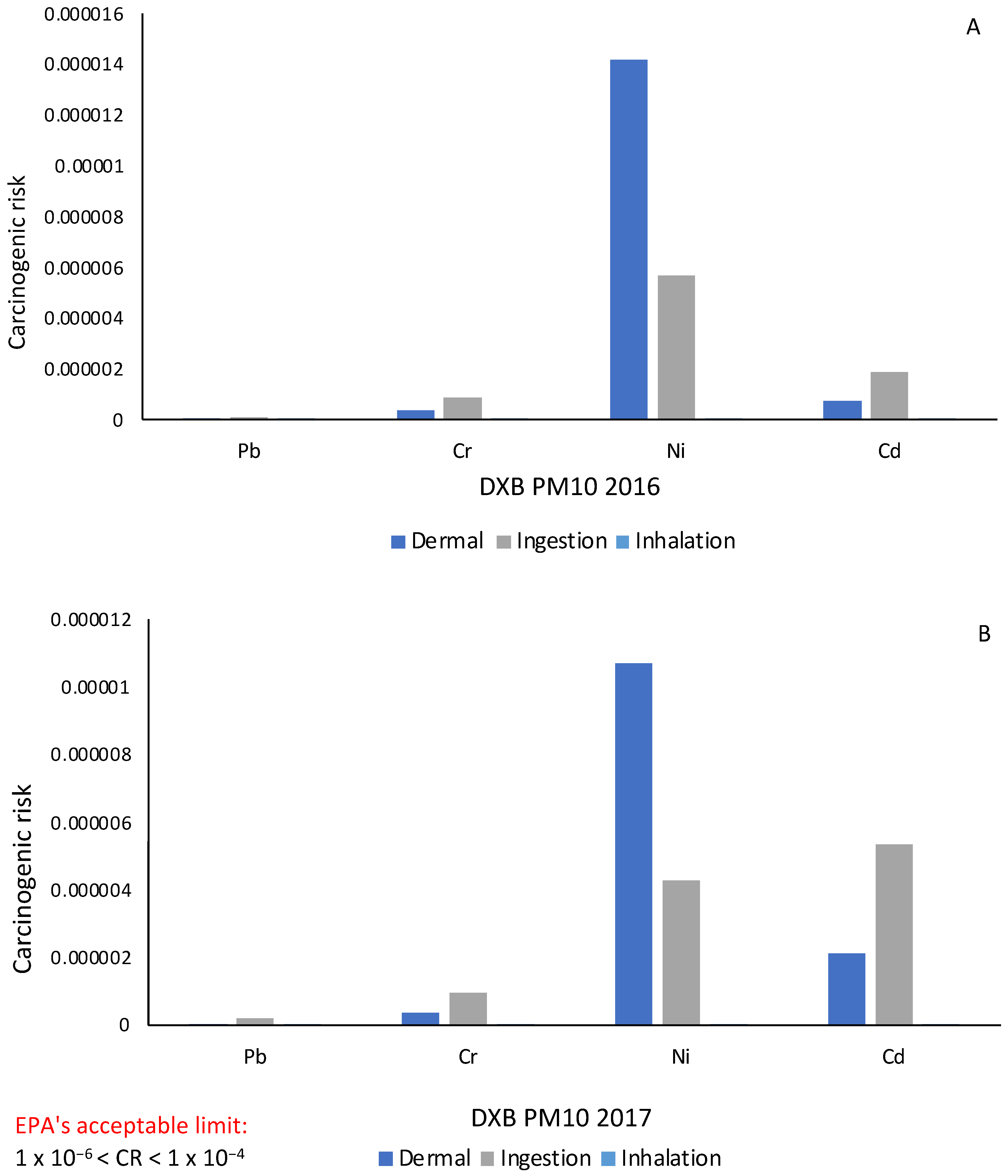
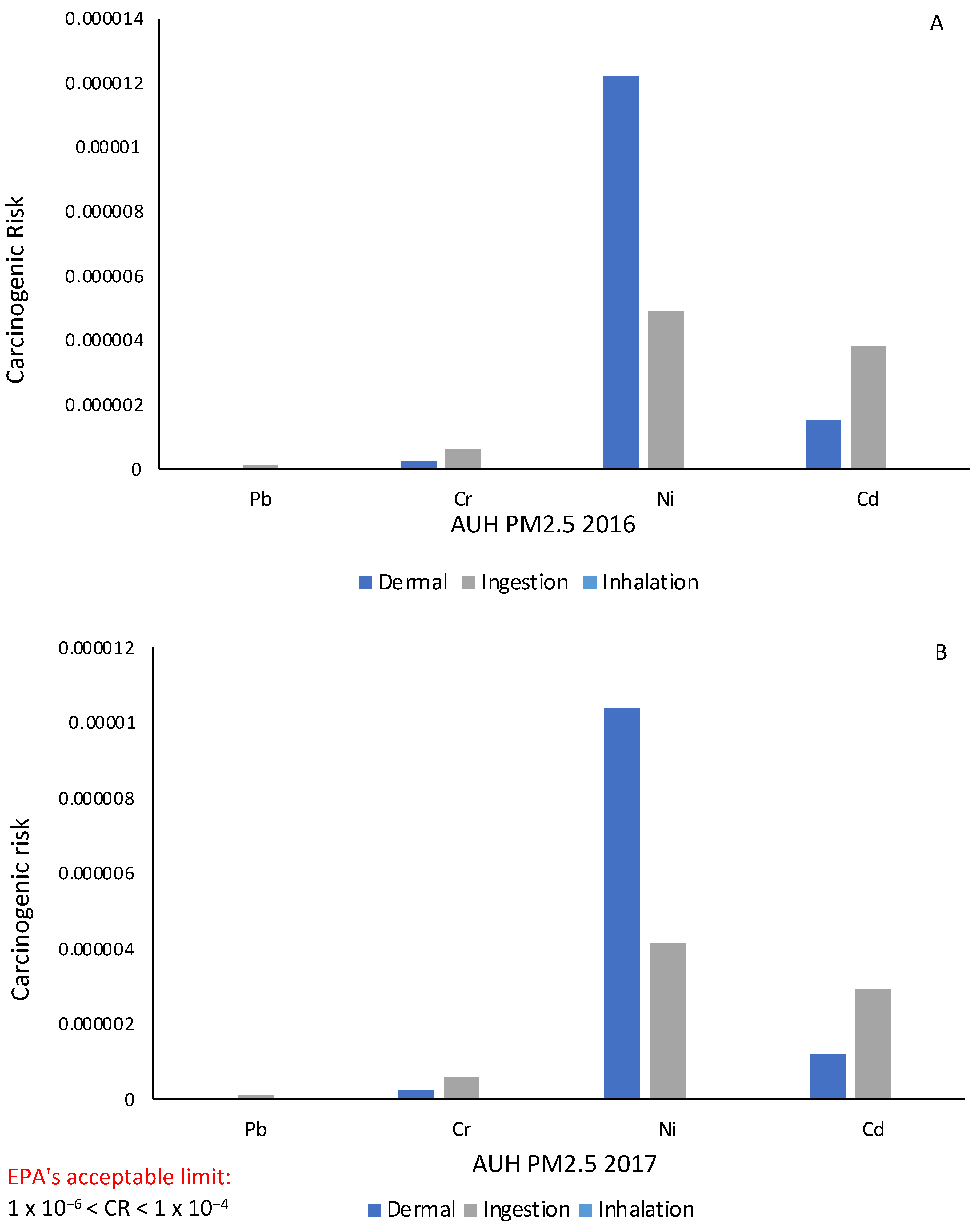
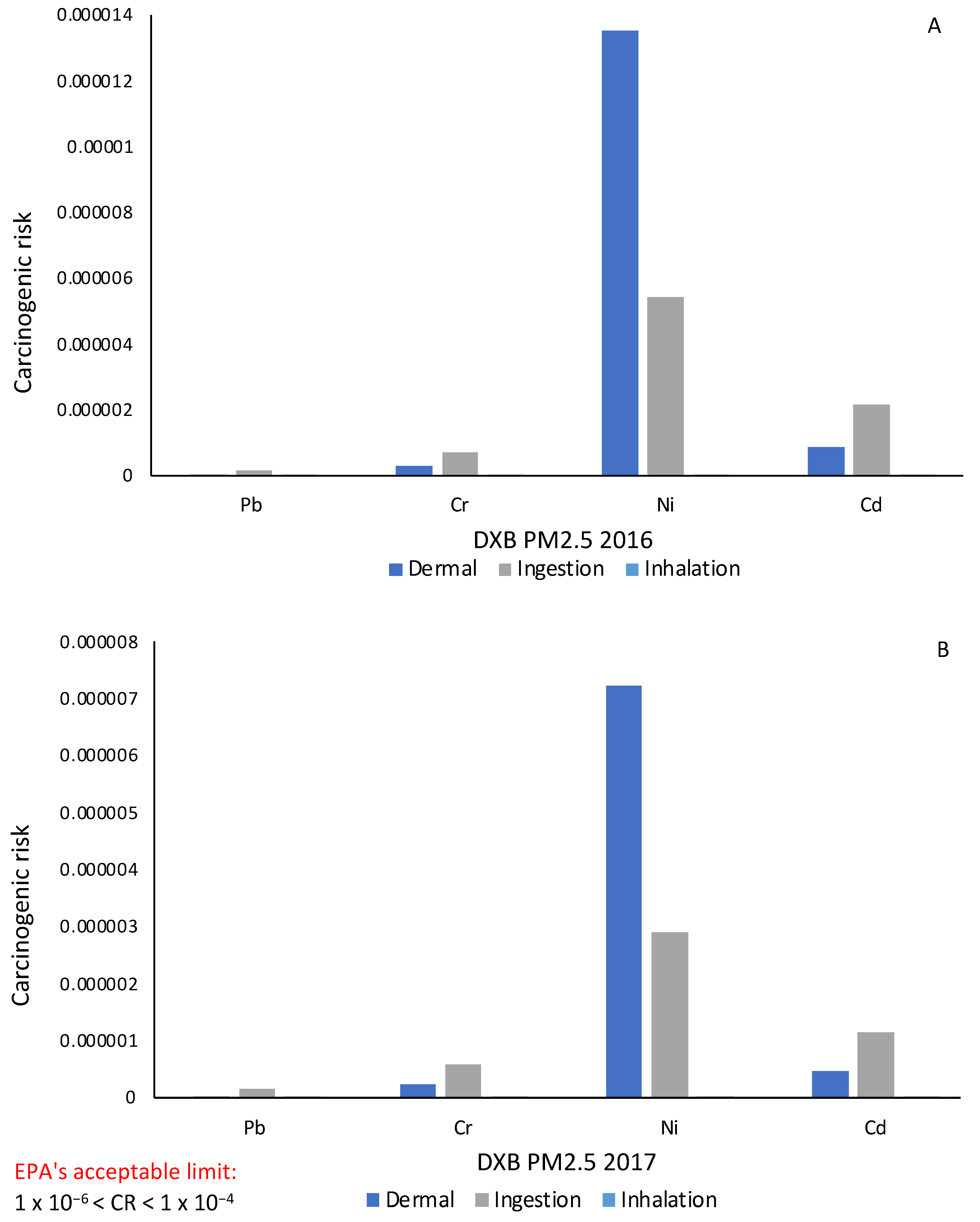


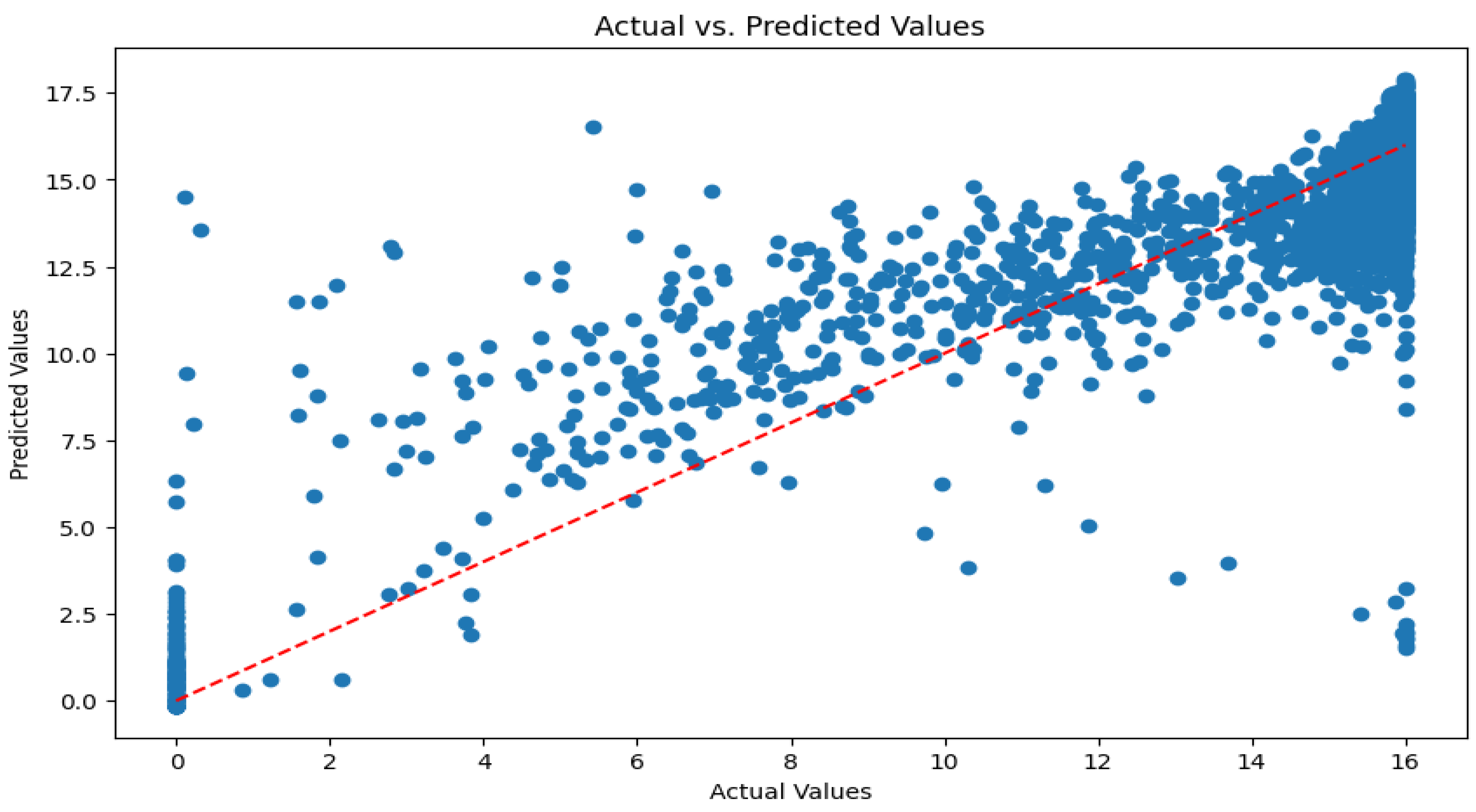
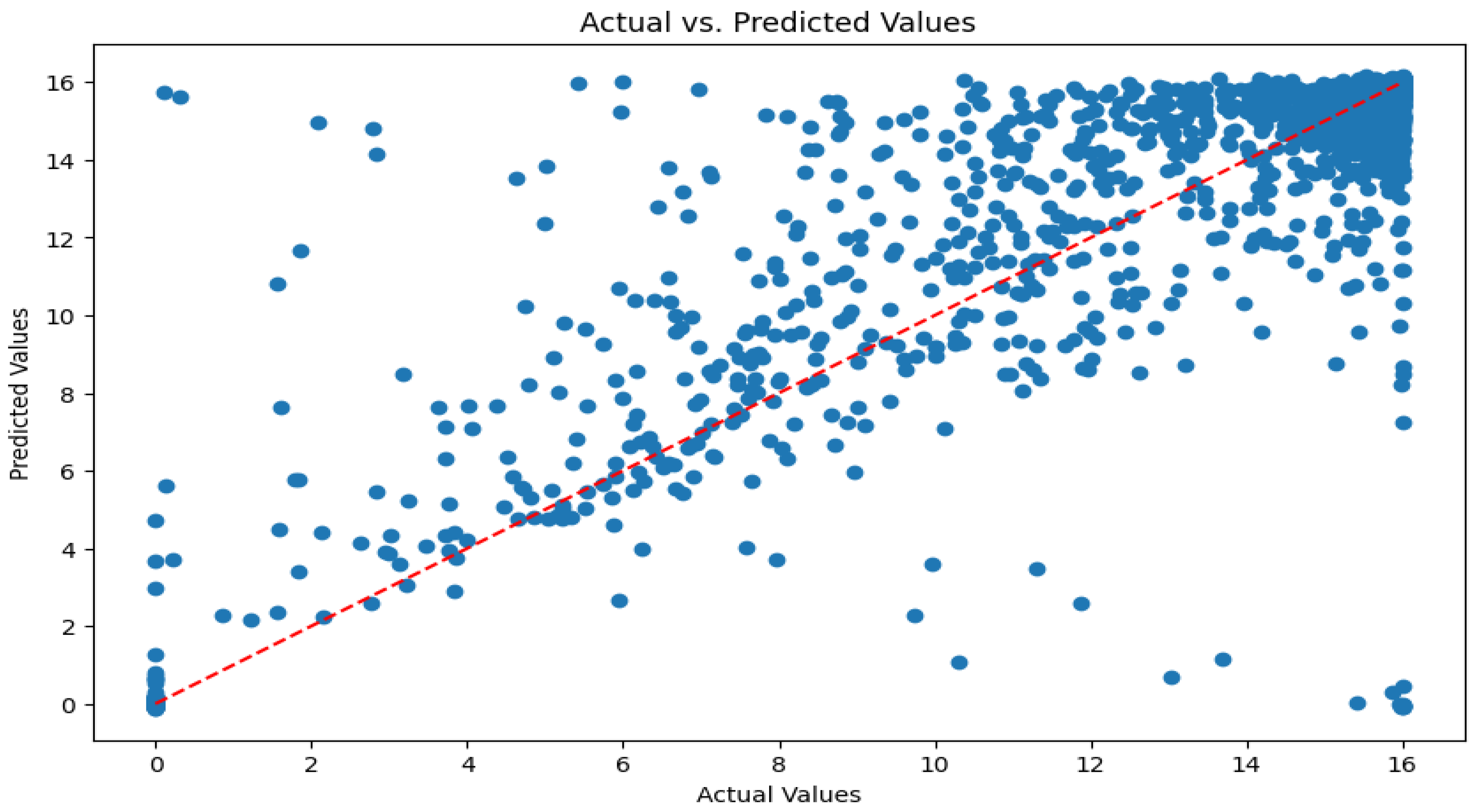
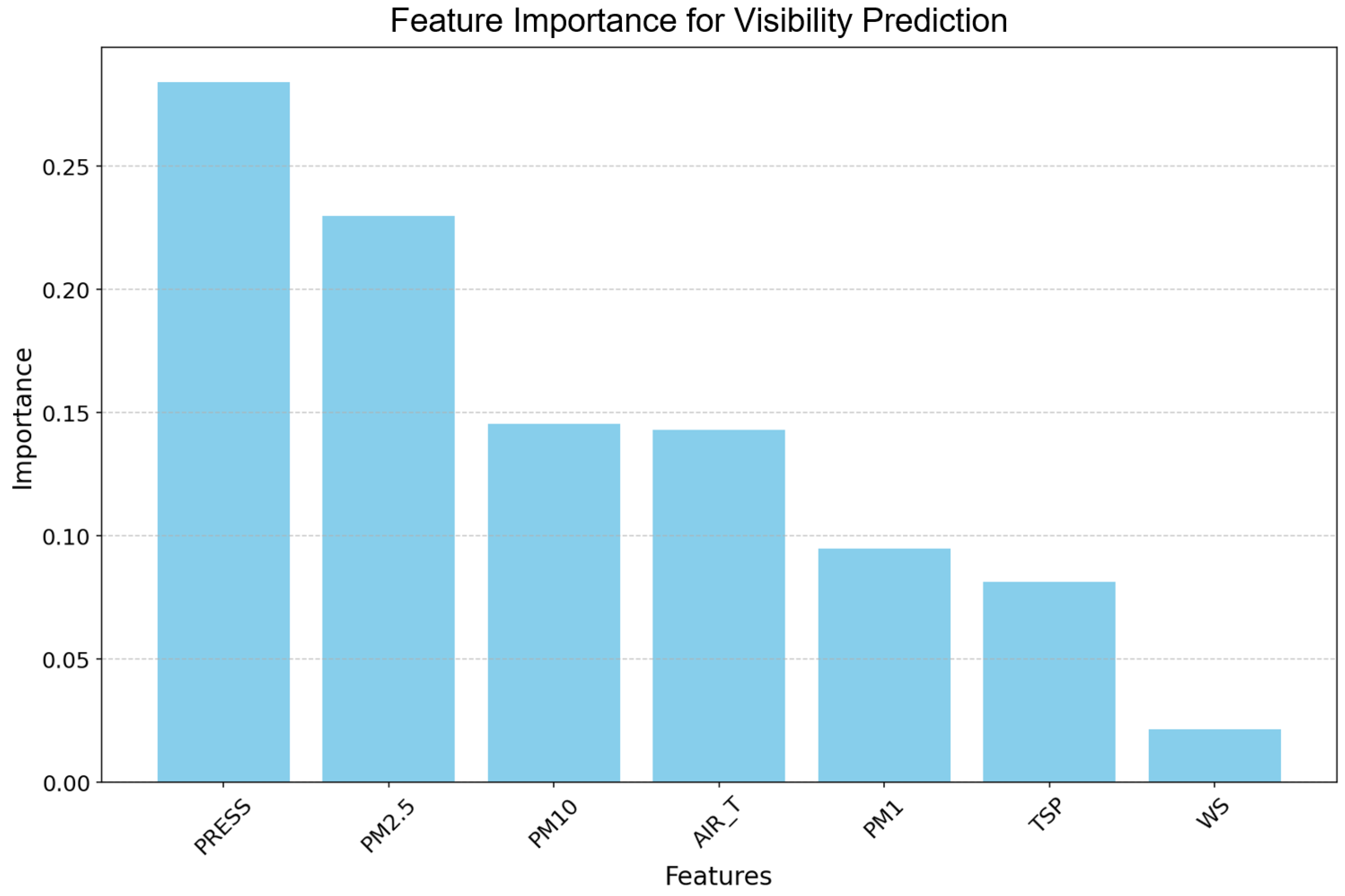
| Location | Year | Cd | Cr | Cu | Ni | Pb | Zn | [mg/kg] |
|---|---|---|---|---|---|---|---|---|
| DXB | 2016 | 0.39 | 1.90 | 3.14 | 8.44 | 18.31 | 40.85 | PM2.5 |
| AUH | 2016 | 0.65 | 1.67 | 2.99 | 8.10 | 19.93 | 44.26 | |
| DXB | 2017 | 0.19 | 1.69 | 3.11 | 4.03 | 22.35 | 8.10 | |
| AUH | 2017 | 0.43 | 1.53 | 3.49 | 4.87 | 20.03 | 8.31 | |
| DXB | 2016 | 0.38 | 2.69 | 5.99 | 9.53 | 18.06 | 55.43 | PM10 |
| AUH | 2016 | 0.36 | 2.60 | 4.58 | 8.73 | 20.38 | 48.73 | |
| DXB | 2017 | 0.76 | 2.76 | 6.52 | 6.40 | 30.02 | 14.97 | |
| AUH | 2017 | 0.11 | 2.48 | 8.41 | 5.05 | 26.84 | 11.48 |
| PM10 ug/m3 | PM2.5 ug/m3 | Temp (°C) | Wind Speed (m/s) | |
|---|---|---|---|---|
| Correlation coefficient with heavy metals | −0.3 | 0.14 | −0.57 | −0.2 |
| p-value | 0.65 | 0.31 | 0.04 | 0.5 |
| Hazard Index (HI) | |||||||
|---|---|---|---|---|---|---|---|
| 2016 | 2017 | ||||||
| Dermal | Ingestion | Inhalation | Dermal | Ingestion | Inhalation | ||
| PM2.5 | DXB | 0.00864 | 0.0270 | 4.10 × 10−6 | 0.00554 | 0.0266 | 4.03 × 10−6 |
| AUH | 0.0115 | 0.0577 | 8.70 × 10−6 | 0.00647 | 0.0226 | 3.42 × 10−6 | |
| PM10 | DXB | 0.0126 | 0.0573 | 8.67 × 10−6 | 0.00893 | 0.0396 | 6.00 × 10−6 |
| AUH | 0.0126 | 0.0565 | 8.57 × 10−6 | 0.00624 | 0.0292 | 4.43 × 10−6 | |
| 2016 | Month | PM1 (µg/m3) | PM2.5 (µg/m3) | PM10 (µg/m3) | TSP (µg/m3) | WS (m/s) | PRESS (hPa) | AIR T (°C) |
|---|---|---|---|---|---|---|---|---|
| 1 | 47.897 | 63.967 | 81.989 | 82.782 | 1.745 | 1013.637 | 20.538 | |
| 2 | 31.408 | 40.284 | 48.761 | 49.112 | 1.494 | 1013.578 | 21.075 | |
| 3 | 28.856 | 47.331 | 60.762 | 61.407 | 1.862 | 1009.241 | 24.250 | |
| 4 | 26.914 | 40.587 | 51.943 | 52.928 | 1.955 | 1006.656 | 26.694 | |
| 5 | 31.569 | 54.409 | 71.560 | 74.177 | 1.931 | 1001.014 | 32.193 | |
| 6 | 39.792 | 71.494 | 160.333 | 164.831 | 1.942 | 996.647 | 34.024 | |
| 7 | 45.742 | 75.995 | 166.238 | 172.345 | 1.986 | 993.310 | 36.153 | |
| 8 | 44.711 | 70.024 | 154.687 | 161.424 | 1.622 | 995.697 | 37.256 | |
| 9 | 41.487 | 54.649 | 114.058 | 117.325 | 1.710 | 999.988 | 33.793 | |
| 10 | 43.214 | 54.183 | 111.854 | 114.600 | 1.408 | 1006.285 | 30.522 | |
| 11 | 44.165 | 55.523 | 115.044 | 117.142 | 1.637 | 1011.559 | 26.469 | |
| 12 | 38.587 | 50.487 | 104.066 | 106.194 | 1.484 | 1013.120 | 23.243 | |
| Average | 38.695 | 56.578 | 103.441 | 106.189 | 1.731 | 1005.061 | 28.851 | |
| 2017 | 1 | 33.132 | 45.427 | 96.869 | 98.710 | 1.866 | 1012.276 | 21.678 |
| 2 | 33.897 | 56.798 | 123.633 | 125.818 | NA | NA | NA | |
| 3 | 35.094 | 57.233 | 124.779 | 128.088 | 1.914 | 1008.645 | 24.731 | |
| 4 | 37.367 | 56.118 | 121.867 | 125.333 | 1.623 | 1005.587 | 29.858 | |
| 5 | 33.988 | 53.292 | 114.014 | 117.498 | 1.811 | 1001.637 | 32.729 | |
| 6 | 32.322 | 44.587 | 92.549 | 94.387 | 1.643 | 995.016 | 35.243 | |
| 7 | 46.863 | 63.737 | 131.422 | 134.804 | 1.695 | 993.247 | 37.724 | |
| 8 | 31.044 | 43.945 | 91.423 | 93.973 | 1.649 | 995.441 | 37.037 | |
| 9 | 45.964 | 53.399 | 106.968 | 108.952 | 1.420 | 1000.941 | 34.481 | |
| 10 | 32.649 | 39.211 | 78.468 | 80.055 | 1.331 | 1005.652 | 31.354 | |
| 11 | 23.848 | 28.840 | 58.246 | 60.152 | 1.546 | 1010.783 | 26.770 | |
| 12 | 30.596 | 37.666 | 76.624 | 79.464 | 1.508 | 1015.181 | 22.237 | |
| Average | 34.730 | 48.354 | 101.405 | 103.936 | 1.637 | 1004.037 | 30.349 |
Disclaimer/Publisher’s Note: The statements, opinions and data contained in all publications are solely those of the individual author(s) and contributor(s) and not of MDPI and/or the editor(s). MDPI and/or the editor(s) disclaim responsibility for any injury to people or property resulting from any ideas, methods, instructions or products referred to in the content. |
© 2025 by the authors. Licensee MDPI, Basel, Switzerland. This article is an open access article distributed under the terms and conditions of the Creative Commons Attribution (CC BY) license (https://creativecommons.org/licenses/by/4.0/).
Share and Cite
Dronjak, L.; Kanan, S.; Ali, T.; Assim, R.; Samara, F. A Multi-Faceted Approach to Air Quality: Visibility Prediction and Public Health Risk Assessment Using Machine Learning and Dust Monitoring Data. Sustainability 2025, 17, 6581. https://doi.org/10.3390/su17146581
Dronjak L, Kanan S, Ali T, Assim R, Samara F. A Multi-Faceted Approach to Air Quality: Visibility Prediction and Public Health Risk Assessment Using Machine Learning and Dust Monitoring Data. Sustainability. 2025; 17(14):6581. https://doi.org/10.3390/su17146581
Chicago/Turabian StyleDronjak, Lara, Sofian Kanan, Tarig Ali, Reem Assim, and Fatin Samara. 2025. "A Multi-Faceted Approach to Air Quality: Visibility Prediction and Public Health Risk Assessment Using Machine Learning and Dust Monitoring Data" Sustainability 17, no. 14: 6581. https://doi.org/10.3390/su17146581
APA StyleDronjak, L., Kanan, S., Ali, T., Assim, R., & Samara, F. (2025). A Multi-Faceted Approach to Air Quality: Visibility Prediction and Public Health Risk Assessment Using Machine Learning and Dust Monitoring Data. Sustainability, 17(14), 6581. https://doi.org/10.3390/su17146581









